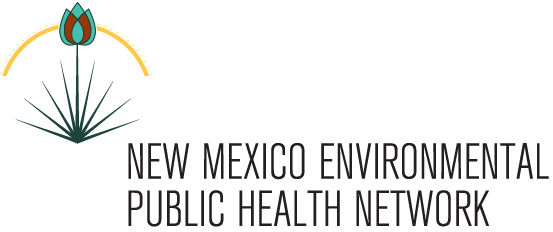Nov 2, 2020 –
NMEPHN Joins Others in Providing Comments on Draft Methane and Ozone Rules
Following the New Mexico policy related to methane issues in our state has been a priority for NMEPHN. The Network supports New Mexico’s commitment to adopt new oil and gas rules to reduce volatile organic compound and methane emissions which contribute to climate change and impact human health. The Network, along with several other organizations committed to public health, recently submitted a letter to the NM Env. Dept. and the NM Energy, Minerals, and Natural Resources Dept. outlining our concerns with the current draft of rules. Among our concerns are that the draft rules include loopholes related to some wells and a proposed 15-ton pollution threshold that would exempt the majority of wells in New Mexico from the rules, thereby eliminating the potential for improving the health of populations living near these wells.
See our letter at the link below:
Thank You for Your Commitment to Protecting New Mexicans’ Health
On Sunday, October 25, The Albuquerque Journal published one of the NMEPHN advisory committee member’s op-eds on the proposed rules. See Dr. Lance Chilton’s Op-Ed
Increase Community Health Via Energy Efficiency
by Tammy Fiebelkorn, Southwest Energy Efficiency Project
Can energy efficiency really improve your health? Yes!
Using less energy reduces carbon emissions, which is vital to fighting climate change. Climate change has serious health impacts including extreme weather, extreme weather events (fires, floods, storms, etc.), and air pollution. All of these climate change impacts negatively impact human health and can be reduced via energy efficiency.
Investment in energy efficiency helps to reduce pollution and emissions, improve indoor and outdoor air quality, and save lives. In New Mexico, 12.6% of adults and over 11% of children are affected by asthma, so reductions in pollution will improve the health of many New Mexicans.
The indoor air quality of homes is also impacted positively by energy efficiency improvements. A home that can be adequately heated and cooled is vital to residents’ health. In low-income homes, we often see a decision to not heat or not cool because of financial restrictions. Energy efficiency reduces energy bills, making it easier to condition the space within the home to a level that promotes health and well-being.
Proper ventilation – which often comes with increased energy efficiency – also improves the health of humans (and animals) who live in those homes. Without proper ventilation, health issues can be exacerbated by chills, breezes, and outdoor air pollutants inside the home.
Building electrification (electricity is inherently more efficient than natural gas or propane) also comes with health benefits. Natural gas is a major contributor to climate change, and fracking for gas causes serious environmental and health problems. Gas furnaces, stoves, and water heaters create dangerous combustion chemicals that can remain in the house after combustion. By installing highly efficient electric appliances such as heat pumps and heat pump water heaters, we can reduce greenhouse gas emissions, minimize potential chemical pollution, and improve human health.
Energy Efficiency for Health Care Providers
Many health care providers are committed to building healthier communities, advocating for those who are low-income and vulnerable, and innovating how and where healing can happen – both inside medical facilities and out in the community. Energy efficiency can assist the medical industry with all these goals.
Medical facilities require a large amount of energy to condition, light, and power their facilities. Energy efficiency can help health care providers spend less on utility costs and reinvest those savings into patient care and helping facilities maintain healthy healing and work environments.
Unlike many other sectors, many health facilities must operate 24 hours a day, seven days a week – even during power outages and extreme weather events. Investments in efficient energy technologies and equipment can help to maintain their services at all times.
Energy efficiency can also be utilized by the entire medical supply chain to support reducing the sector’s overall costs, thus potentially reducing the overall costs of health care to consumers.
There are many reasons to support increased energy efficiency – possibly the most important is the impact on community and individual health that can be brought about by simply using less energy. For more information on the link between energy use and health, check out Physicians for Social Responsibility at www.psr.org.
There are many energy efficiency programs in New Mexico that individuals and corporations can take advantage of to improve their efficiency. Here are just a few to start:
- Investor Owned Utilities in NM are required by the Efficient Use of Energy Act to provide their customers with energy efficiency programs ranging from low-income energy efficiency to commercial efficiency assistance. Check with your IOU for details.
- The State of New Mexico’s Energy Conservation and Management Division oversees numerous clean energy tax credits and has staff with expertise in energy efficiency: Learn More
- The State of New Mexico’s Economic Development Department offers the Rural Efficient Business Program: Learn More
***
Tammy Fiebelkorn is the New Mexico Representative for Southwest Energy Efficiency Project (SWEEP). SWEEP is a public interest organization promoting greater energy efficiency in Arizona, Colorado, Nevada, New Mexico, Utah, and Wyoming. For more information, visit www.swenergy.org.
Resources:
1. https://www.cdc.gov/asthma/stateprofiles/asthma_in_nm.pdf
2. https://www.psr.org/
Continued Links Found Between Racial Inequities, Environmental Impacts and COVID 19
Nearly half of Americans breathe unsafe outdoor air—and they are disproportionately non-White and low-income people. In late August, new research presented to the House Committee on Oversight and Reform revealed that the health impacts of air pollution are twice as bad as previously estimated. Of relevance to the current pandemic, recent studies have shown that poor air quality amplifies the effects of COVID-19.
Race, more than income, has been linked to the unequal impact of particulate matter pollution. A recent Rocky Mountain Institute (RMI) report cites a 2018 US Environmental Protection Agency (EPA) study which found that Black Americans were exposed to 1.54 times more fine particulate matter (PM2.5) than the rest of the population. People in poverty were 1.35 times more exposed and all nonwhites were 1.28 times more exposed.
In the report, RMI makes recommendations that can be acted on locally to directly address these inequity and air pollution issues including transitioning to clean heating, reducing vehicular pollution by reducing reliance on single-occupancy vehicles and accelerating electrification, invest in urban greening initiatives and engaging utilities to clean up the electric grid through cleaner energy resources.
See the full RMI report.
New Mexico’s Smoky Skies Can Impact Public Health
One of the many unfortunate environmental challenges impacting public health in the last few months in New Mexico has been deteriorating air quality from wildfires from throughout the West. The New Mexico Department of Health, the New Mexico Environment Department, and the Albuquerque Environmental Health Department have issued multiple health alerts to New Mexicans impacted by wildfires.
As climate change continues to impact our planet, wildfire seasons are longer and wildfires are burning hotter. This year has been a record year for wildfires in the United States — more than 6 million acres of land have burned and more than 40 people have died.
One of the many pollutants found in wildfire smoke is particle pollution, the tiny solid and liquid particles suspended in the air. These particles are so small that they enter and lodge deep in the lungs. Particle pollution triggers asthma attacks, heart attacks, and strokes — and can kill. According to the American Lung Association, studies of children in California found that children who breathed the smoky air during wildfires had more coughing, wheezing, bronchitis, colds, and were more likely to have to go to the doctor or to the hospital for respiratory causes, especially from asthma.
Carbon monoxide (CO) is also another threat from forest fire smoke. This colorless, odorless gas is common during the smoldering stages of a fire. Inhaling CO reduces oxygen delivery to the body’s organs and tissues and can lead to headaches, nausea, dizziness, and, in high concentrations, premature death. Wildfires spread many other harmful emissions, including nitrogen oxides and many hazardous air pollutants.
Because children breathe more air per minute than adults and have lungs that are still developing, they are especially vulnerable to health effects during wildfires, especially children who are incredibly young or who already have respiratory diseases.
There is little long-term research on the health impacts of these fires though scientists are starting to take deeper looks at these impacts. One study conducted by the University of Montana looked at a western Montana town that was inundated with smoke for 50 days in 2017 and found that residents’ lung functions were even worse a year after the smoke cleared. Follow-up efforts on this research have currently been derailed by the pandemic. In California, where people are exposed to smoke year after year, researchers are looking at the effects of that on pregnant women and infants. A recent National Public Radio story indicated that calls to medical clinics in Oregon have significantly increased during recent wildfires.
How can we protect our health and the health of those around us? Health and environmental professionals recommend using the 5-3-1 method for determining whether it is safe to be outside when skies are smoky.
If visibility is:
- Under 5 miles – Air quality is unhealthy for young children, adults over 65, pregnant women and people with lung and heart disease, asthma or other respiratory illnesses. Outdoor activity should be minimized.
- Around 3 miles – Young children, adults over 65, pregnant women, and people with lung and heart disease, asthma or other respiratory illnesses should avoid all outdoor activity.
- Around 1 mile – Air quality is unhealthy for everyone. People should remain indoors and avoid all outdoor activities. Stay inside your home, workplace or in a safe shelter.
For more information on air quality and protecting your health, visit: https://nmtracking.org/environment/air/FireAndSmoke.html
To find out information on current wildfires are, visit http://newmexico.gov/New_Mexico_Wildfire_Alerts.aspx
For more information on wildfire impacts on children, see the Western States Pediatric Environmental Health at https://wspehsu.ucsf.edu/projects/wildfires-and-childrens-health





